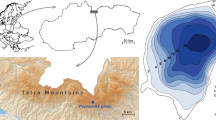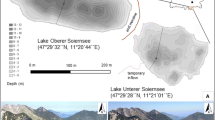Abstract
Transects of surface sediment samples were taken in 4 lakes from the Sylvania Wilderness Area, Upper Peninsula of Michigan. These surface samples were compared with diatom samples from a core taken in the Northwest basin of Crooked Lake, also from the Sylvania Wilderness Area. Weighted Averaging calibration was used to reconstruct lake depths in Crooked Lake using the diatom microfossils from the core and the surface samples to infer past lake depth. During the early Holocene the lake was dominated by planktonic species and diatom-inferred water depth was large – approx. 13 m. At about 6700 BP inferred water depth was 2 m and samples were dominated by Fragilaria construens var. venter – a species characteristic of shallow parts of the surface sample transects. From 6700 to 5000 BP reconstructed water level was at its shallowest. From 5000 to 3000 BP it increased. This rise in water level was marked by increasing abundances of Aulacoseira ambigua and occurred at the same time increasing percentages of hemlock pollen indicate increasing available moisture. Modern water depth was reached about 3000 BP. The water level changes at Crooked Lake are consistent with regional climate changes in the Upper Midwest during the Holocene. The lake was shallowest during the mid-Holocene warm period documented by other investigators. It deepened as the Midwestern climate became cooler and wetter during the late Holocene.
Similar content being viewed by others
References
Almquist-Jacobson, H., 1995. Lake level fluctuations at Ljustjäarnen, central Sweden and their implications for the Holocene climate of Scandinavia. Paleogeogr. Paleoclimat. Paleoecol. 118: 268–290.
Barker, P. A., N. Roberts, H. Lamb, S. vander Kaarst & A. Benkaddour, 1994. Interpretation of Holocene lake level change from diatom assemblages in Lake Sidi Ali, Middle Atlas, Morocco. J. Paleolimnol. 12: 223–234.
Bernabo, J. C. & T. Webb, 1977. Changing patterns in the Holocene pollen record of northeastern North America: A mapped summary. Quat. Res. 8: 64–96.
Bradbury, J. P. & T. C. Winter, 1976. Areal distribution and stratigraphy of diatoms in the sediments of Lake Sallie, Minnesota. Ecology 57: 1005–1014.
Brugam, R. B., 1993. Surface sample analogues of Elk Lake fossil diatom assemblages. In Bradbury, J. P. & W. E. Dean (eds), Elk Lake, Minnesota: Evidence for Rapid Climate change in the North Central United States, Boulder Colorado, Geological Special Paper 276: 189–214.
Brugam, R. B., M. Giorgi, C. Sesvold, S. M. Johnson & R. Almos, 1997. Holocene Vegetation History in the Sylvania Wilderness Area of the Western Upper Peninsula of Michigan. Am. Midl. Nat. 137: 166–175.
Brugam, R. B. & S. M. Johnson, 1997. Holocene Lake-Level rise in the Upper Peninsula of Michigan, U.S.A. as indicated by peatland growth. The Holocene. 7: 353–357.
Brugam, R. B. & J. A. Vallarino, 1989. Paleolimnological investigations of human disturbance in Western Washington lakes. Archiv füur Hydrobiologie 116: 129–159.
Camburn, K. E., J. C. Kingston & D. F. Charles, 1986. PIRLA diatom iconograph. PIRLA unpublished report series, Report No. 3. Indiana University Biology Department. Bloomington, IN, USA.
Davis, M. B., K. D. Woods, S. L. Webb & R. P. Futyma, 1986. Dispersal versus climate: Expansion of Fagus and Tsuga into the Upper Great Lakes Region. Vegetatio 67: 93–103.
Digerfeldt, G., 1986. Studies on past lake-level fluctuations. In B. Berglund (ed.), Handbook of Holocene Palaeoecology and Palaeohydrology, 127–143.
Digerfeldt, G., 1988. Reconstruction and regional correlation of Holocene lake-level fluctuations in Lake Bysjöon, South Sweden. Boreas 17: 165–182.
Digerfeldt, D., J. D. Almendinger & S. Bjöork, 1992. Reconstructions of past lake levels and their relation to groundwater hydrology in the Parkers Prairie Sand Plains, West Central Minnesota. Paleogeogr. Paleoclimatol. Paleoecol. 94: 92–118.
Duthie, H. C., J-R. Yang, J. W. D. Edwards, B. B. Wolfe & B. G. Warner, 1996. Hamilton Harbor, Ontario: 8300 years of limnological and envrionmental change inferred from microfossil and isotopic analyses. J. Paleolimnol. 15: 79–97.
Hustedt, F., 1930. Die Süusswasserflora Mitteleuropas Heft 10 Bacillariophyta (Diatomeae) 466 pp.
Hustedt, F., 1977. Die Kieselalgen Deutschlands, Osterreichs und der Schweiz. Teile 1, 2 und 3. Band VII Kryptogamen Flora Deutschland, Osterreich und der Schweiz, L. Rabenhorst. Otto Koeltz, Koenigstein, Germany. 920, 845 & 816 pp.
Kingston, J. C., R. E. Lowe, E. F. Stoermer & T. B. Ladewski. 1983. Spatial and temporal distribution of benthic diatoms in northern Lake Michigan. Ecology. 1566–1580.
Kutzbach, J. E. & T. Webb III, 1988. The use of paleoclimatic data in understanding climatic change. In Proceedings of the Carbon Dioxide Climatic Research Program Conference. Lois E. Schmitt (ed.) U.S. Department of Energy, 163–172.
Line, J. M., C. J. F. ter Braak & H. J. B. Birks, 1994. WACALIB version 3.3 — a computer program to reconstruct environmental variables from fossil assemblages by weighted averageing and to derived sample-specific errors of prediction. J. Paleolimnol. 10: 147–152.
Parshall, T., 1995. Canopy mortality and stand-scale change in a northern hemlock-hardwood forest. Can. J. For. Res. 125: 1466–1478.
Patrick, R. & C.W. Reimer, 1966. The diatoms of the United States 1. Academy of Natural Sciences, Philadelphia, Monograph No. 13, 668 pp.
Patrick, R. & C.W. Reimer, 1975. The diatoms of the United States 2. Academy of Natural Sciences, Philadelphia. Monograph No. 13, 213 pp.
Peterson, W. L., 1986. Late Wisconsin glacial history of northeastern Wisconsin and western Upper Michigan. U.S. Geological Survey Bulletin 1652. U.S. Government Printing Office, Washington, D.C., 14 pp.
Phillips, D. W., 1978. Environmental climatology of Lake Superior. J. Great Lakes Res. 4: 288–309.
PIRLA, 1986. Diatom Iconograph. Paleolimnological Investigations of Recent Lake Acidification Project. Indiana University, Bloomington.
Smol, J., 1988. Paleoclimate proxy data from freshwater arcit diatoms. Verh. int. Ver. Limnol. 23: 837–844.
Watts, W. A. & T. C. Winter, 1966. Plant macrofossils from Kirchner Marsh, Minnesota — A paleoecological study. Geol. Soc. Am. Bull. 77: 1339–1360.
Webb, T., 1974. A vegetational history from Northern Wisconsin: Evidence from modern and fossil pollen. Am. Midl. Nat. 92: 12.34
Webb, T., P. J. Bartlein, S. P. Harrison & K. H. Anderson. 1993. Vegetation, lake levels, and climate in Eastern North America for the past 18 000 years. Chap. 17 In H. E. Wright, J. E. Kutzbach, T. Webb, W. F. Ruddiman, F. A. Street-Perrott & P. J. Bartlein (eds), Global Climates Since the Last Glacial Maximum, 415–467.
Winkler, M. G., 1988. Effect of climate on development of two Sphagnum bogs in south-central Wisconsin. Ecology 69: 1032–1043.
Winkler, M. G., A. M. Swain & J. E. Kutzbach, 1986. Middle Holocene dry period in the northern midwestern United States: Lake levels and pollen stratigraphy. Quat. Res. 25: 235–250.
Wolin, J. A., 1992. Paleoclimatic Implications of Late Holocene Lake level Fluctuations in Lower Herring Lake, Michigan Ph.D. Thesis. University of Michigan, 155 pp.
Wolin, J. A., 1996. Late Holocene lake level and lake development signals in Lower Hering Lake, Michigan. J. Paleolimnol. 15: 19–45.
Wright, H. E., 1980. Cores of soft lake sediments. Boreas 9: 107–114.
Yang, JR. & H. C. Duthie, 1995. Regression and weighted averaging models relating surficial sedimentary diatom assemblages to water depth in Lake Ontario. J. Great Lakes Res. 21: 84–94.
Author information
Authors and Affiliations
Rights and permissions
About this article
Cite this article
Brugam, R.B., McKeever, K. & Kolesa, L. A diatom-inferred water depth reconstruction for an Upper Peninsula, Michigan, lake. Journal of Paleolimnology 20, 267–276 (1998). https://doi.org/10.1023/A:1007948616511
Issue Date:
DOI: https://doi.org/10.1023/A:1007948616511




